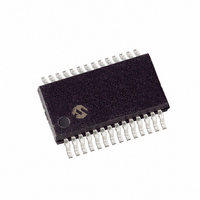PIC16F873A-I/SS Microchip Technology, PIC16F873A-I/SS Datasheet - Page 18

PIC16F873A-I/SS
Manufacturer Part Number
PIC16F873A-I/SS
Description
IC MCU FLASH 4KX14 EE 28SSOP
Manufacturer
Microchip Technology
Series
PIC® 16Fr
Datasheets
1.PIC16F616T-ISL.pdf
(8 pages)
2.PIC16F688T-ISL.pdf
(688 pages)
3.PIC16F873A-ISO.pdf
(234 pages)
4.PIC16F873A-ISO.pdf
(6 pages)
5.PIC16F873A-ISO.pdf
(4 pages)
6.PIC16F873A-ISO.pdf
(6 pages)
7.PIC16F873A-ISO.pdf
(4 pages)
8.PIC16F873A-ISO.pdf
(22 pages)
Specifications of PIC16F873A-I/SS
Core Size
8-Bit
Program Memory Size
7KB (4K x 14)
Core Processor
PIC
Speed
20MHz
Connectivity
I²C, SPI, UART/USART
Peripherals
Brown-out Detect/Reset, POR, PWM, WDT
Number Of I /o
22
Program Memory Type
FLASH
Eeprom Size
128 x 8
Ram Size
192 x 8
Voltage - Supply (vcc/vdd)
4 V ~ 5.5 V
Data Converters
A/D 5x10b
Oscillator Type
External
Operating Temperature
-40°C ~ 85°C
Package / Case
28-SSOP
Controller Family/series
PIC16F
No. Of I/o's
22
Eeprom Memory Size
128Byte
Ram Memory Size
192Byte
Cpu Speed
20MHz
No. Of Timers
3
Core
PIC
Processor Series
PIC16F
Data Bus Width
8 bit
Maximum Clock Frequency
20 MHz
Data Ram Size
192 B
Data Rom Size
128 B
On-chip Adc
Yes
Number Of Programmable I/os
22
Number Of Timers
3
Operating Supply Voltage
2 V to 5.5 V
Mounting Style
SMD/SMT
A/d Bit Size
10 bit
A/d Channels Available
5
Height
1.75 mm
Interface Type
I2C, SPI, USART
Length
10.2 mm
Maximum Operating Temperature
+ 85 C
Minimum Operating Temperature
- 40 C
Supply Voltage (max)
5.5 V
Supply Voltage (min)
4 V
Width
5.3 mm
Lead Free Status / RoHS Status
Lead free / RoHS Compliant
For Use With
AC164307 - MODULE SKT FOR PM3 28SSOPAC164020 - MODULE SKT PROMATEII 44TQFPXLT28SS-1 - SOCKET TRANSITION ICE 28SSOP
Lead Free Status / Rohs Status
Details
Other names
PIC16F873AI/SS
Available stocks
Company
Part Number
Manufacturer
Quantity
Price
Company:
Part Number:
PIC16F873A-I/SS
Manufacturer:
Microchip Technology
Quantity:
1 812
Part Number:
PIC16F873A-I/SS
Manufacturer:
MICROCHIP/微芯
Quantity:
20 000
- PIC16F616T-ISL PDF datasheet
- PIC16F688T-ISL PDF datasheet #2
- PIC16F873A-ISO PDF datasheet #3
- PIC16F873A-ISO PDF datasheet #4
- PIC16F873A-ISO PDF datasheet #5
- PIC16F873A-ISO PDF datasheet #6
- PIC16F873A-ISO PDF datasheet #7
- PIC16F873A-ISO PDF datasheet #8
- Current page: 18 of 688
- Download datasheet (3Mb)
PICmicro MID-RANGE MCU FAMILY
1.4
DS31001A-page 1-6
Development Support
Microchip offers a wide range of development tools that allow users to efficiently develop and
debug application code. Microchip’s development tools can be broken down into four categories:
1.
2.
3.
4.
All tools developed by Microchip operate under the MPLAB™ Integrated Development Environ-
ment (IDE), while some third party tools may not. The code generation tools include:
• MPASM
• MPLAB-C
• MP-DriveWay™
These software development programs include device header files. Each header file defines the
register names (as shown in the device data sheet) to the specified address or bit location. Using
the header files eases code migration, and reduces the tediousness of memorizing a register’s
address or a bit’s position in a register.
Tools which ease in debugging software are:
• PICMASTER
• ICEPIC In-Circuit Emulator
• MPLAB-SIM Software Simulator
After generating and debugging the application software, the device will need to be programmed.
Microchip offers two levels of programmers:
1.
2.
Demonstration boards allow the developer of software code to evaluate the capability and suit-
ability of the device to the application. The demo boards offered are:
• PICDEM-1
• PICDEM-2
• PICDEM-3
• PICDEM-14A
A full description of each of Microchip’s development tools is discussed in the
Tools”
from the Microchip web site (www.microchip.com) or from your local Microchip Sales Office.
Code development recommendations and techniques are provided in the
section.
Microchip offers other reference tools to speed the development cycle. These include:
• Application Notes
• Reference Designs
• Microchip web site
• Microchip BBS
• Local Sales Offices with Field Application Support
• Corporate Support Line
Additional avenues of assistance can be found in many Web User Groups including the MIT
reflector PIClist. The Microchip web site lists other sites that may be useful references.
Note:
Code generation
Software debug
Device programmer
Product evaluation boards
PICSTART Plus programmer
PROMATE II programmer
section. As new tools are developed, product briefs and user guides may be obtained
Microchip strongly recommends that the supplied header files be used in the source
code of your program. This eases code migration as well as increases the quality
and depth of the technical support that Microchip can offer.
®
In-Circuit Emulator
1997 Microchip Technology Inc.
“Code Development”
“Development
Related parts for PIC16F873A-I/SS
Image
Part Number
Description
Manufacturer
Datasheet
Request
R

Part Number:
Description:
Manufacturer:
Microchip Technology Inc.
Datasheet:

Part Number:
Description:
IC MCU FLASH 4KX14 EE 28SOIC
Manufacturer:
Microchip Technology
Datasheet:

Part Number:
Description:
IC MCU FLASH 4KX14 EE 28DIP
Manufacturer:
Microchip Technology
Datasheet:

Part Number:
Description:
IC MCU FLASH 4KX14 EE 28SOIC
Manufacturer:
Microchip Technology
Datasheet:

Part Number:
Description:
IC MCU FLASH 4KX14 EE 28DIP
Manufacturer:
Microchip Technology
Datasheet:

Part Number:
Description:
IC MCU FLASH 4KX14 EE 28SOIC
Manufacturer:
Microchip Technology
Datasheet:

Part Number:
Description:
IC MCU FLASH 4KX14 EE 28SOIC
Manufacturer:
Microchip Technology
Datasheet:

Part Number:
Description:
IC MCU FLASH 4KX14 EE 28DIP
Manufacturer:
Microchip Technology
Datasheet:

Part Number:
Description:
IC MCU FLASH 4KX14 EE 28DIP
Manufacturer:
Microchip Technology
Datasheet:

Part Number:
Description:
IC MCU FLASH 4KX14 EE 28DIP
Manufacturer:
Microchip Technology
Datasheet:

Part Number:
Description:
IC MCU FLASH 4KX14 EE 28SOIC
Manufacturer:
Microchip Technology
Datasheet:

Part Number:
Description:
IC,MICROCONTROLLER,8-BIT,PIC CPU,CMOS,SOP,28PIN,PLASTIC
Manufacturer:
Microchip Technology
Datasheet:

Part Number:
Description:
IC,MICROCONTROLLER,8-BIT,PIC CPU,CMOS,DIP,28PIN,PLASTIC
Manufacturer:
Microchip Technology
Datasheet:

Part Number:
Description:
IC MCU FLASH 4KX14 EEPROM 18DIP
Manufacturer:
Microchip Technology
Datasheet:

Part Number:
Description:
IC MCU FLASH 4KX14 EEPROM 18SOIC
Manufacturer:
Microchip Technology
Datasheet:











